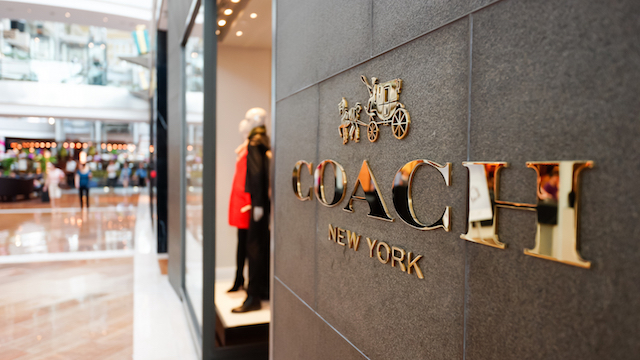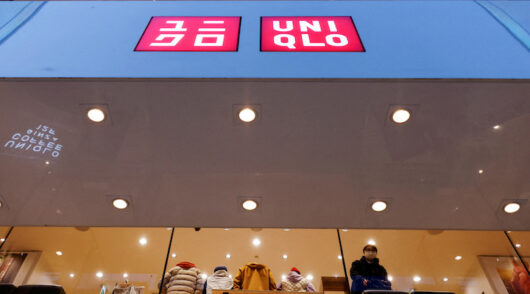Coach sales in greater China slipped 2 per cent in the latest quarter, with “continued softness” in Hong Kong and Macau offsetting strong growth and positive comparable store sales in the mainland, the company said.
On a constant-currency basis, sales rose 2 per cent. In Japan, sales rose 2 per cent in dollar terms and decreased 1 per cent in constant currency.
“Sales for the remaining directly-operated businesses in Asia decreased low-double digits on a reported and constant currency basis, due primarily to weakness in Korea where macroeconomic and geopolitical headwinds have pressured spending from domestic consumers and tourists,” Coach said in a statement.
Globally, Coach slipped offtrack, with net sales of US$995 million for the third quarter to April 1, down 4 per cent on a reported basis and 3 per cent on a constant currency basis. But the company said it was anticipating a reduction due to changes in its US wholesaling operations as it pulled back from department store channels.
CEO Victor Luis described the brand’s performance as solid, and in line with expectations and strategic initiatives. Year-on-year quarterly income fell from $122 million to $112 million. North American sales fell 5 per cent.
“In a volatile and complex global environment, we delivered continued positive comparable store sales for the Coach brand in North America and gross margin expansion in each segment, while tightly controlling costs. We continued to drive growth in our directly-operated Europe and Mainland China businesses, which represent the most significant geographic opportunities for our brands. And, despite our deliberate pullback in the North America wholesale channel and the impact of calendar shifts, we delivered earnings growth.”
Net sales for the Stuart Weitzman brand totaled $80 million for the third fiscal quarter compared to $79 million reported in the same period of the prior year, an increase of 1 per cent, impacted by wholesale shipment timing. Gross profit for the Stuart Weitzman brand totaled $50 million, an increase of 8 per cent.
Strategy brings pain, but necessary
Neil Saunders, MD of GlobalData Retail, said that as much as Coach’s latest quarterly results may seem like a step back after recent progress, there are some mitigating factors which make the results more palatable.
“Contributory reasons for the decline include the later timing of Easter which diluted sales growth, the stiffer comparative from last year when sales increased by a fairly hefty 11.2 per cent, and a stronger dollar which put a dent in sales and earnings from overseas operations.
“As important as these factors are, the foremost consideration is the continued pullback of distribution through US department stores; this resulted in a 40 per cent fall in sales via the channel. This is a much sharper rate of decline than during the prior quarter and underlines the fact that Coach is now seriously dialing back its reliance on what was once a vital route to market for the brand. Naturally, this strategy causes pain on the top line. However, it is also a vital step in rebuilding the premium status Coach wants to regain,” said Saunders.
“There are plenty of indications that the strategy is working. Firstly, Coach is now making market share gains across higher price point bags and accessories – an indication that consumers are willing to spend bigger bucks on the brand than they were a year or so ago. Secondly, the company’s own brand stores are doing relatively well, posting a 3 per cent increase in comparable sales this quarter. Part of this is down to a partial transfer of trade from department stores; but the better brand profile is also drawing in some new customers, especially at the younger end of the age spectrum.”
Saunders said the net result of this is that despite the pressure on the topline, Coach is engineering a much better set of profit numbers as margins ease up. Excluding Stuart Weitzman, operating income at Coach rose by 14 per cent to $147 million during the quarter.
“We believe that further margin enhancement can be made over the course of this year and that a 19 per cent operating margin target is reasonable by the end of the fiscal.
“Now that Coach is on a clear path to recovery we believe it is right for the company to explore options for future growth. Some of this will come from the core brand which has the potential to become more of a lifestyle destination. However, Coach needs to be conservative in this push, if only to avoid the previous pitfalls of ubiquity. As such, we see this route to expansion as having limitations.”
Jimmy Choo in sights
Saunders said this is one of the reasons why the company is exploring options to buy other brands.
“Following a failed tilt at Burberry last year, Coach is rumored to have Kate Spade, Jimmy Choo and others in its crosshairs. Given Coach’s successful turnaround and integration of Stuart Weitzman, we believe that such a deal could pay dividends and would allow Coach to create a portfolio of brands similar to other luxury houses. This would allow it to generate growth beyond that from its ongoing recovery.
“In our view, Kate Spade has the most potential if only because it is in the early stages of developing its own lifestyle brand and would benefit from Coach’s sourcing and distribution expertise, as well as some fresh thinking on the design front. It would also allow Coach to access a slightly different demographic and potentially prevent the brand falling into the hands of rival Michael Kors. That said, it seems that talks with Kate Spade have recently stalled which underlines the complexity of dealmaking in the current market.”
Saunders said that with Coach now on a stronger business footing, Coach is right to take its time over any acquisition.
“It must neither overpay nor rush into buying a brand that does not have the right fit or potential. To do so would simply undo much of the progress which has been made to date.”






